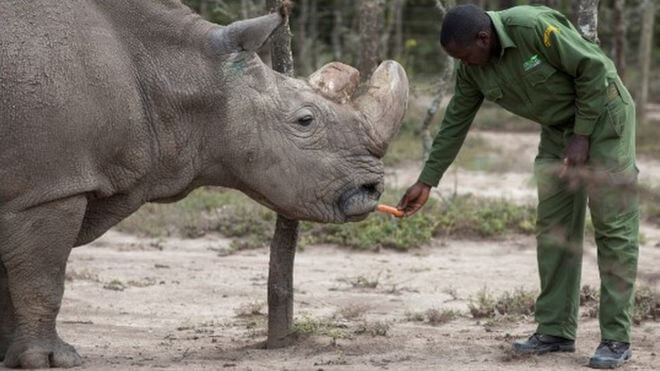 The seemingly “disastrous” story of the world’s most endangered mammal – the northern white rhino – could be rewritten by IVF, scientists claim.
The seemingly “disastrous” story of the world’s most endangered mammal – the northern white rhino – could be rewritten by IVF, scientists claim.
They used the method to produce rhino embryos with sperm from two dead males.
The embryos were made using eggs from a closely related sub-species, but the scientists say the method could save the northern white rhino.
One of the team said he hoped a baby that’s fully northern white rhino would be born “within three years”.
This could provide a way of “rescuing valuable genes” from a sub-species that is already functionally extinct; the last male northern white rhino, named Sudan, died earlier this year at the age of 45.
Only two females now remain, but the researchers who carried out this project say their carefully-developed method of assisted reproduction could work with eggs harvested from those two precious animals.
How do you carry out rhino IVF?
In the journal Nature Communications, Prof Thomas Hildebrandt, from the Leibniz Institute for Zoo and Wildlife Research in Berlin, and his international team of colleagues, described the complexities of safely extracting an egg, or oocyte, from a two-tonne female rhino.
“You can’t reach the ovaries by hand, so we developed a special device,” Prof Hildebrandt explained to BBC News. “We used ultrasound to very precisely inject a needle into [the area of the ovary that releases] eggs.”
This was done while the female southern white rhino was under general anaesthetic, but the process is still very risky. Very close to the ovaries, Prof Hildebrandt explained, is a “huge artery” that if punctured would probably cause the rhino to bleed to death.
But once viable eggs were safely preserved, the team then had the challenge of fertilising them with sperm from male northern white rhinos – animals that died several years ago. They injected each egg with the sperm and used pulses of electrical current to stimulate the egg and sperm to fuse.
The result – viable embryos containing genetic material from a sub-species that is already functionally extinct.
“Everyone believed there was no hope for this sub-species,” said Prof Hildebrandt. “But with our knowledge now, we are very confident that this will work with northern white rhino eggs and that we will be able to produce a viable population.”
Could this bring back the northern white rhino?
These researchers think so, and others around the world who have been involved in efforts to save the northern white rhino say it is an important step.
But Dr Terri Roth, from Cincinnati Zoo, said the team’s suggestion that they would have a “new baby on the ground” within three years was “optimistic”.
“Embryo transfer [into a surrogate mother] in rhinos is in its infancy and has not yet been successful in any rhino species,” Dr Roth told BBC News.
“And there are just two female northern white rhinos alive today, so acquiring white rhino [eggs] will be challenging and their number will be limited. Any embryos produced would likely need to be cryopreserved (or frozen) until a surrogate could be set up.”
Why are there so few northern white rhinos left?
As Dr Roth explained, poaching is the primary threat facing all rhino species.
“The most effective way to save rhinos from extinction is to stop the poaching, however, that has proven difficult,” she told BBC News.
“In the late 1990s, even the wild northern white rhino had a chance to recover from low numbers until civil unrest broke out in the DRC and the rhinos were all killed.”
Loss of habitat is the other primary threat to rhinos, and conservationists say that governmental protection of parks and reserves is now essential.
“The proper legislation must be passed, the resources to enforce the regulations must be provided and the law must be upheld,” said Dr Roth, who has worked in rhino conservation for more than two decades.
“It is important that we learn from the plight of the northern white rhino and we make sure what happened to it does not happen to other endangered species.
“As impressive as science can be, we should not reach a point where these hi-tech approaches are the only source of hope for rescuing genes of valuable individuals, sub-species or entire species.”
Read the full BBC News article by